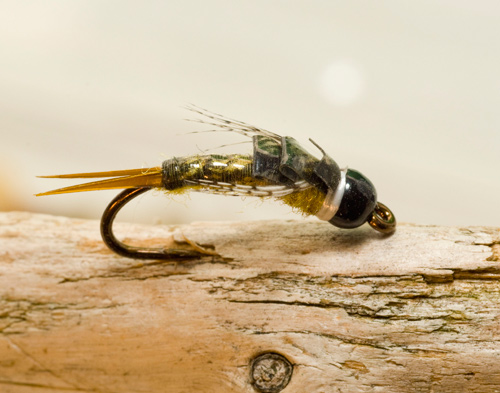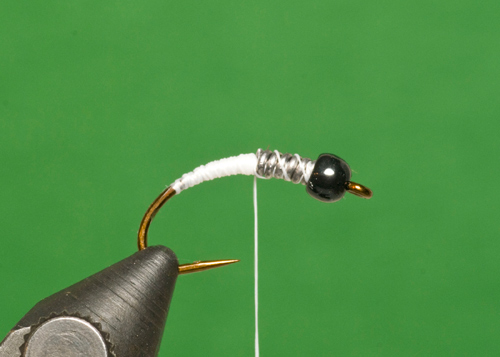|
Czech Stone-By Andy Larkin

Hook: Daiichi 1120 or 1150, #8-#14 (Weighted)
Thread: MFC 8/0 or UTC 70, white
Tail: Brown goose biots
Rib: 6x tippet material
Shellback: Natural mottled Thin Skin
Abdomen: Golden Stone, Antron Sparkle Dubbing
Wingcases: Natural mottled Thin Skin
Thorax: Golden stone Antron Sparkle Dubbing
Legs: Partridge
Bead: Black Tungsten
The presence of stonefly nymphs in a body of water is a testament to its water quality. Like us, stonefly nymphs need cool, oxygenated water to survive. The kind of water found in fast flowing sections of a river or stream.
The rough water stonefly nymphs prefer to inhabit is both a blessing and a curse for us as fly tyers. In fast flows fish have little time to inspect our flies, a welcome bonus. In order get our flies down through the water, where trout hug the bottom, patterns must be weighted or have additional weight added to the leader. In some instances both options are necessary. The risk of hanging up on bottom is high and can exact a steep toll on your fly box. Due to these environmental factors the best patterns stonefly nymph pattern are a blend of key features and simplicity. Andy Larkin’s Czech Stone is a perfect example.
Compared to other aquatic invertebrates, stoneflies are robust. Their flat wide bodies enable them to crawl amongst the bottom rubble and debris with a reduced risk of being swept downstream. Chenille, yarn, dubbing, V-Rib even wire can be used by themselves or together as stonefly nymph body materials. Dubbing blends of black, brown and golden or dirty yellow are my favorite choices for imitating a natural translucent look of a stonefly nymph body.
Lead wire or lead wire substitute underbodies are a common stonefly nymph tying practice. Lashing the lead along the sides of the hook shank creates a wide body shape while providing needed weight. This technique is common with larger stonefly nymph patterns. Side shank weighting also forms the blunt abdominal tip common to all stonefly nymphs. A small dubbing ball can also be used suggest the blunt abdominal tip while helping to create split tails.
Dislodged drifting stonefly nymphs, like many nymphs, adopt a curved posture. Curved shank hooks do an excellent job suggesting a stonefly’s humped profile but tend to roll inverted when weighted. Nymphs such as the Czech Stone use this inverted profile to their advantage when coupled with the Euro Nymphing presentation technique. Casting upstream to give the fly time to sink use your fly rod to lead the fly under tension. During the drift the weighted fly rides inverted, bouncing off rocks and other obstructions snag free. Relying on feel rather than indicators takes are transmitted almost instantly. Once mastered, Euro nymphing is a deadly.
Stonefly nymphs have a defined pronotum, the first segment of the thorax located just behind their head. The pronotum is often imitated on larger patterns, size 8 or greater. Dubbed heads are common and are sometimes combined with mono eyes for added realism.
Many patterns use metal or tungsten beads to suggest the pronotum. Tungsten or metal beads also add weight and an attractive flash. You can also add additional beads within the thorax to create heavyweight patterns for exploring deep swift flows.
Located just behind the nymph’s pronotum is a distinct pair of easily imitated wingcases. For years natural quill sections, such as white tip turkey or goose, were common wingcase materials. Lacquered for added durability, natural quill segments can be sculpted to shape using scissors or wing burners.
Today, synthetic wingcase materials are popular. Thin Skin Scud Back or Midge Flex are my favorite synthetic wingcase materials. Durable and easy to work with, Thin Skin, Scud Back and Midge Flex can also be shaped and trimmed like lacquered quills.
Thin Skin is a .004” thick pliable rectangular sheet attached to a paper backing. Prior to tying in, Thin Skin is trimmed to width and pealed from the backing. It comes in a variety of colors including mottled schemes resembling natural quill markings.
Scud Back comes in two widths, 1/8” and 1/4”. Narrow widths make excellent shellbacks and wingcases on smaller stonefly nymphs. Wide Scud Back makes excellent wingcases and pronotums on larger stonefly nymphs. Scud Back can be colored using permanent markers to create mottled or dark edged wingcases.
Legs, tails and antenna are prominent stonefly nymph features that should always be imitated. Goose biots are a time honoured tail or antenna material. Partridge and other soft hackle fibers make excellent legs, particularly on smaller patterns. You can also pick and tease out a dubbed thorax to suggest legs.
As with wingcases, synthetic materials have imposed their influence imitating legs, tails and antenna. Round rubber hackle, both barred and solid colors, Sili Legs and Stretch Floss are my favorite antenna and leg choices, especially for larger patterns. These materials are durable, springing to life underwater. Permanent markers can be used to create realistic variegated leg markings. Sometimes, stark color contrasts between legs and body prove irresistible to fish. Simple leggy attractor nymphs have been guide favorites for years.
I keep my leg, tail or antenna proportions similar to the natural stonefly nymphs when using soft hackle and goose biots. When using synthetic materials such as Super Floss I prefer exaggerated length legs, tails and antenna for enhanced jiggle and bounce. As the nymph drifts and tumbles along the bottom fish find this tantalizing action almost irresistible.
Stonefly nymphs, big and small, light or dark, are a staple within my moving water fly box. Andy Larkin’s Czech Stone provides an excellent example of the traits needed to be featured in a potent stonefly pattern. To see more of Andy's innovative patterns, including on line video tying instrucitons, please visit his Fly Blaster Blog.
Tying Instructions

1) Slide bead onto the hook and slide forward to the hook eye. Wind the thorax portion of the hook with .020” or .025” lead wire or lead wire substitute. Push the lead wire tight against the rear of the bead. Cover the lead and shank with tying thread. Build up a small thread ramp behind the lead wire to lock it in place.
To view the rest of this article, please login or join now for free!
|



